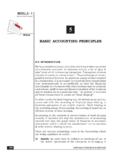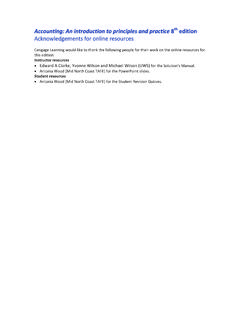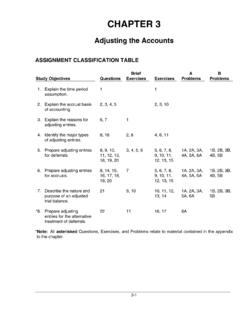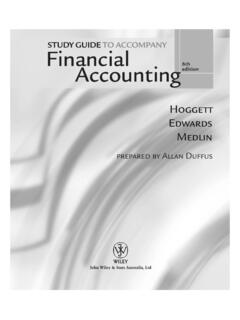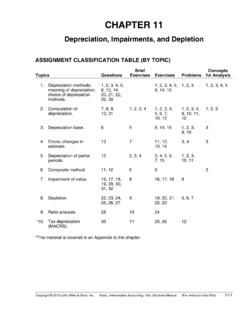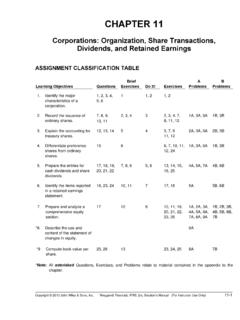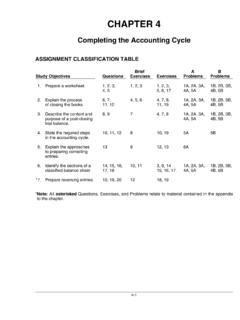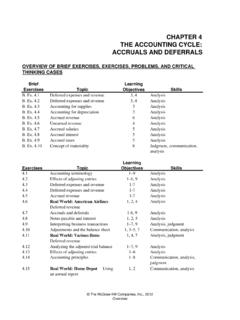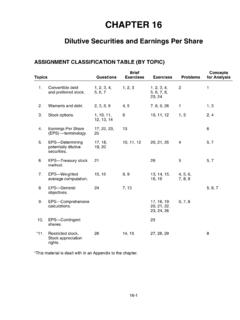Transcription of seventh edition Advanced Financial Accounting - EKSK
1 Advanced Financial Accounting seventh edition Advanced Financial Accounting Richard Lewis and David Pendrill Richard Lewis and David Pendrill Rigorous in its approach, Advanced Financial Accounting tackles the more complex issues of the subject in a lively The new edition and engaging manner. Familiar in its structure and treatment of basic concepts, this seventh edition has been explains the considerable changes which thoroughly revised and updated to reflect recent and are scheduled to take place in the European planned developments in Financial reporting. Union during the next few years This leading text continues to provide both clear examines the increasing importance of the explanations and critical evaluations of current Accounting IASB and international standards practice, especially as found in national and international includes greater focus on international Advanced Accounting standards, and relates them to the needs of developments users of Financial statements.
2 Provides in-depth discussion of all The seventh edition is accompanied by a downloadable important areas, including controversial Solutions Manual which is available to lecturers on the Financial Accounting issues such as Accounting for Financial website at As with the instruments, goodwill and share options, as previous edition , annual updates are also available online. well as exploring the impact of the major Advanced Financial Accounting is written for second and changes that have occurred in the third year Financial Accounting students on Accounting or Accounting treatment of pension costs business studies degrees and is also suitable for MBA. includes numerous questions, now grouped courses. The book provides extensive coverage of the together at the ends of chapters syllabuses for the Advanced papers in Financial Accounting seventh edition and Financial reporting of the ACCA, CIMA, ICAEW, ICAI and ICAS.
3 seventh edition Richard Lewis MSc, FCA, is Co-Director of the Centre for Higher Education Research and Information at the Open University. He was formerly a Pro-Vice-Chancellor of the Open University and Deputy Chief Examiner of the Council for National Lewis and Pendrill Academic Awards. Prior to that, he was Sir Julian Hodge Professor of Accounting at the University of Wales, Aberystwyth, and Head of the Accountancy Department at what is now London Metropolitan University. David Pendrill BSc(Econ), MSc, FCA, CTA, LTCL, is the Esm e Fairbairn Professor of Accounting and Financial Management at the University of Buckingham, where he was Head of the Department of Accounting and Finance for more than a decade. He was formerly a Senior Lecturer in Accountancy at what is now Cardiff University and has taught at the London School of Economics as well as at universities in Canada, Singapore and the West Indies.
4 An imprint of Advanced Financial Accounting We work with leading authors to develop the strongest educational materials in business and finance, bringing cutting-edge thinking and best learning practice to a global market. Under a range of well-known imprints, including Financial Times Prentice Hall, we craft high quality print and electronic publications which help readers to understand and apply their content, whether studying or at work. To find out more about the complete range of our publishing please visit us on the World Wide Web at: seventh edition Advanced Financial Accounting Richard Lewis MSc, FCA. Co-Director of the Centre for Higher Education Research and Information, Open University David Pendrill BSc(Econ), MSc, FCA, CTA, LTCL. Esm e Fairbairn Professor of Accounting and Financial Management, University of Buckingham Pearson Education Limited Edinburgh Gate Harlow Essex CM20 2JE.
5 England and Associated Companies around the world Visit us on the World Wide Web at: First published under the Pitman imprint 1981. Second edition published 1985. Third edition published 1991. Fourth edition published 1994. Fifth edition published under the Financial Times Pitman Publishing imprint 1996. Sixth edition published under the Financial Times Prentice Hall imprint 2000. seventh edition published 2004. Richard Lewis, David Pendrill and David S. Simon 1981, 1985. Richard Lewis and David Pendrill 1991, 1994, 1996, 2000, 2004. The rights of Richard Lewis and David Pendrill to be identified as authors of this work have been asserted by the authors in accordance with the Copyright, Designs, and Patents Act 1988. All rights reserved; no part of this publication may be reproduced, stored in a retrieval system, or transmitted in any form or by any means, electronic, mechanical, photocopying, recording, or otherwise without either the prior written permission of the Publishers or a licence permitting restricted copying in the United Kingdom issued by the Copyright Licensing Agency Ltd, 90 Tottenham Court Road, London W1T 4LP.
6 ISBN 0 273 65849 2. British Library Cataloguing-in-Publication Data A catalogue record for this book can be obtained from the British Library. 10 9 8 7 6 5 4 3 2 1. 08 07 06 05 04. Typeset in 10/12pt Minion by 30. Printed and bound in Great Britain by Bell and Bain Ltd, Glasgow. The publisher's policy is to use paper manufactured from sustainable forests. Brief contents Preface xiii Part 1 The framework of Financial reporting 1. 1 The search for principles 3. 2 Sources of authority: the United Kingdom 23. 3 Sources of authority: the rise of international standards 42. 4 What is profit? 59. Part 2 Financial reporting in practice 93. 5 Assets I 95. 6 Assets II 133. 7 Liabilities 160. 8 Financial instruments 176. 9 Substance over form and leases 205. 10 Pension costs 248. 11 Reporting Financial performance 276.
7 12 Taxation: current and deferred 337. 13 Business combinations and goodwill 359. 14 Investments and groups 403. 15 Associates and joint ventures 447. 16 Overseas involvement 476. 17 Expansion of the annual report 526. 18 Capital reorganisation, reduction and reconstruction 579. Part 3 Accounting and price changes 617. 19 Accounting for price changes 619. 20 Current cost Accounting 644. 21 Beyond current cost Accounting 666. Index 703. Contents Preface xiii Part 1 The framework of Financial reporting 1. 1 The search for principles 3. Overview 3. Introduction 3. Accounting theory 5. The FASB conceptual framework project 8. The IASC/IASB framework 11. The ASB's Statement of principles 12. Summary 21. Recommended reading 21. Questions 22. 2 Sources of authority: the United Kingdom 23.
8 Overview 23. Introduction 23. Legislation 24. Stock Exchange rules 27. Accounting concepts 28. Standardisation 31. The Government's proposals 37. Summary 39. Recommended reading 39. Some useful websites 39. Questions 40. 3 Sources of authority: the rise of international standards 42. Overview 42. International standardisation 42. Harmonisation in the European Union 46. The EU Regulation of 2002 and the problems that it poses 50. Summary 55. Recommended reading 55. Some useful websites 56. Questions 56. viii Contents 4 What is profit? 59. Overview 59. Introduction 59. Present value of the business 61. Measurement of wealth by reference to the valuation of individual assets 61. Capital maintenance 65. The usefulness of different profit measures 71. How do we choose? 73. The limitations of historical cost Accounting 73.
9 Interim summary 77. Distributable profits 77. Realised profits 81. Summary 86. Recommended reading 87. A useful website 87. Questions 87. Part 2 Financial reporting in practice 93. 5 Assets I 95. Overview 95. Introduction 95. The basis of valuation 98. Tangible fixed assets 100. Depreciation 110. Investment properties 116. Intangible assets 118. Differences in the treatment of tangible and intangible fixed assets 122. Impairment reviews 122. Summary 127. Recommended reading 127. Questions 128. 6 Assets II 133. Overview 133. Introduction 133. Stocks and long-term contracts 134. Research and development 144. Government grants 146. Summary 149. Recommended reading 149. Questions 150. Contents ix 7 Liabilities 160. Overview 160. Introduction 160. Liabilities 162. Provisions and contingencies 165.
10 Summary 171. Recommended reading 171. Questions 171. 8 Financial instruments 176. Overview 176. Introduction 176. FRS 4 Capital Instruments 177. Hedge Accounting 189. Derivatives 191. The valuation of Financial instruments 193. FRED 30 and the convergence programme 197. Summary 201. Recommended reading 201. Questions 202. 9 Substance over form and leases 205. Overview 205. Introduction 206. Reflecting the substance of transactions 206. Leases 214. Beyond SSAP 21 236. Summary 238. Recommended reading 238. Questions 239. 10 Pension costs 248. Overview 248. Introduction 248. SSAP 24 Accounting for Pension Costs 252. From SSAP 24 to FRS 17 259. FRS 17 Retirement Benefits 260. Summary 271. Recommended reading 271. Questions 271. 11 Reporting Financial performance 276. Overview 276.

